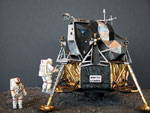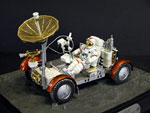Code 3 Collectibles' Apollo Astronaut, Lunar Module, and Lunar Rover
Review by Robert Pearlman
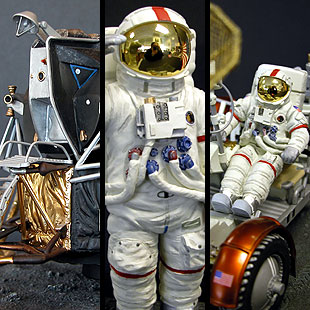
To fire and rescue teams, Code 3 translates to "respond with lights and sirens", which is the highest level of alert. The term was a perfect fit for a company producing high quality replicas of fire engines.
Its not the first thing that comes to mind when thinking about aviation and space vehicles.
In the case of Code 3 Collectibles however, its entirely appropriate. You should set your own sirens blaring and get the first three models released as part of their new National Air and Space Museum collection.
Jointly developed with the Smithsonian Institution, the artists at Code 3 Collectibles had two goals: recreate historic moments in space history with more detail and at a lower price point than their closest competition.
"There are many 'air' models in the marketplace at every detail level, material (die cast, wood, model kit) and price," commented Erin McMahon, spokesperson for Code 3 Collectibles in an interview with collectSPACE. "However, we believe that by focusing on historically significant aircraft and by adding our touch for extreme detail, we will be able to provide the collector with models that are as innovative in design as they are collectible."
Though they also plan to model aircraft from the National Air and Space Museum's collection, Code 3 Collectibles' first release is focused on space.
"We chose [Apollo] for our first releases because we believe the average collector can really identify with this incredible period of space exploration," said McMahon. "Many collectors experienced history in the making when watching the Apollo missions on television."
Each limited edition model retails for $132, which can be paid over four monthly installments. When this review was being written, Code 3 Collectibles was offering free acrylic cases to anyone who ordered all three models. (The cases were also available for purchase separately for $5.00 each, marked down from $35.00.)
The hand casted and painted models ship separately in large cardboard boxes. Fitted styrofoam surround each, with ties securing the major components. Each model's base is packed at the bottom of the styrofoam case, in its own divided section.
As Code 3 Collectibles prides themselves on their attention to detail, I decided to visit the source of their inspiration -- the National Air and Space Museum -- to review each individual model.
Apollo Astronaut
"America Wins The Space Race"
Dimensions: 9"(L) X 11"(H) X 11"(W) / 6.62 lbs.
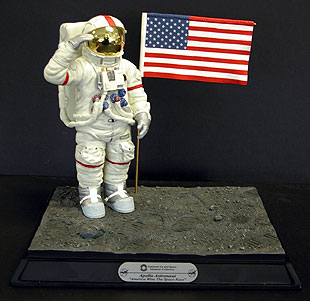
The first thing one notices about the Apollo Astronaut is its size. Standing 11 inches tall on its base, the model is the largest of the three released.
Code 3 Collectibles says the model is representative of all 12 moonwalkers. That said, I am fairly certain that it was inspired by a photograph of Apollo 17 Commander Eugene Cernan. Not only is the pose similar, but the suit configuration, presence of the red stripes and perhaps most telling, Apollo 17 patch points to this being none other than the last man on the Moon.
Given the upcoming 30th anniversary of Apollo 17, Code 3 Collectibles might do well to promote this connection. The same astronaut (scaled down) appears in the other two models, telling the story of the final lunar landing.
 At left is Cernan's actual suit, as it appears on display at the National Air and Space Museum. It is missing the Portable Life Support System (PLSS) backpack, as it was left on the Moon to save weight. At left is Cernan's actual suit, as it appears on display at the National Air and Space Museum. It is missing the Portable Life Support System (PLSS) backpack, as it was left on the Moon to save weight.
Comparing the two, the replica appears bloated. On the Moon, the suit was pressurized, which helps to account for some of the bulge. I personally would have preferred if it had shed a few millimeters, but its girth grows on you.
|
If the helmet and in particular, the visor looks different, it is because on the model, the opaque side and center shades are retracted. Both the real and replica visors however, are coated in gold.
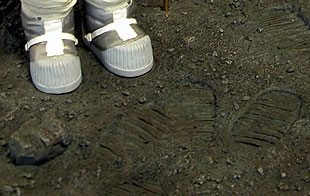
That's not to say the astronaut was the only focus for the artists at Code 3 Collectibles. The flag is sculpted to recreate conspiracy theorists' oft-cited ripples (and the horizontal support bar which they always seem to ignore).
The base, with its lunar rocks and pebbles, also includes lunar boot prints (though curiously, the indentations where the astronaut actually stands are sans treads).
Overall, the Apollo Astronaut may not be my favorite of the three, but it is a striking addition to my collection.
Lunar Module
"One Small Step..."
Dimensions: 9"(L) X 7"(H) X 11"(W) / 4.94 lbs.
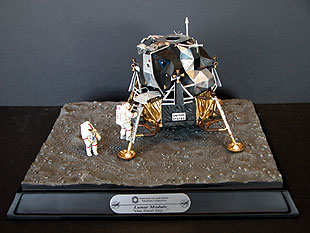
My father was a model builder. Whether from a kit or scratch, he could turn out amazing scale miniatures of everything from sailing ships to spacecraft.
I inherited his passion for models, but have yet to develop the patience needed to build and paint them. I've tried and the results have not been pretty.
I therefore take great delight when a company decides to take a design previously available as a kit and release it as a sculpture. Such is the case with Code 3 Collectibles' Lunar Module.
If you've followed me thus far, than you know I am referring to the Monogram First Lunar Landing diorama kit. My father built this model for me when I was a kid, and I always liked how it included astronauts to put the LM into scale. Its the component missing from the Franklin Mint's Lunar Module, which is probably the best known diecast LM in collections today.
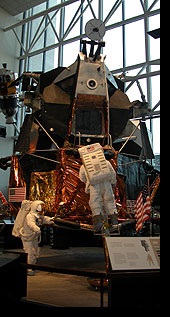 Not that I am suggeting that Code 3 Collectibles needed a miniature for inspiration. No, they had something much larger. Not that I am suggeting that Code 3 Collectibles needed a miniature for inspiration. No, they had something much larger.
At left is the real Lunar Module on display at the National Air and Space Museum. No need for scale references here; you need only to walk up to get an idea for its size.
You can also see where Code 3 Collectibles got the idea for their astronauts positioning. Comparing the two, you can see the subtle differences but we'll get to that soon.
|
One last comment about the astronauts. If I had any question that Code 3 Collectibles was serious about insuring accuracy, it was answered without any doubt after speaking with Erin McMahon.
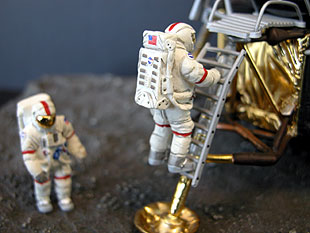
As you can clearly see in the photograph above, both astronauts have red stripes! When I called McMahon to point out their error, she beat me to the punch. "Oh, you mean the two commanders? We're fixing that."
"We're replacing the astronaut on the ladder, as the commander was first to leave the LM and last to enter."
She had me at hello. For a company with no previous experience creating spacecraft, they had certainly done their homework.
That said, my theory that these three models tell the story of Apollo 17 sort of falls apart here. The LM more closely matches the Apollo 11 configuration than 17. Of course, if it is Eagle, than neither of the astronauts should have red stripes (they weren't seen until 14).
Oh well, that's not Code 3 Collectibles' error. They did say that these models were representative of all missions. Its only fitting that they should incorporate features from various flights.
If I have one complaint about the Lunar Module, its the lack of clear instructions for setting it up for display. Though printed instructions are included, two details are either overlooked or oversimplified.
First, the correct positioning of the Lunar Module on its base is not immediately apparent. Unlike the Franklin Mint model (for example), where indentations mark where the LM footpads should rest, the only real indication of where to place Code 3 Collectible's LM is the footprints of the astronaut already on the surface. I had to assume that where the treads end, the ladder must begin.
Similarly, while instructions do show how to attach the astronaut to the ladder, they do not show which rung to position his feet. I first tried the bottom rung but any minor vibration caused him to fall off. I finally found that resting his arms on the porch, he would stay attached.
Lunar Roving Vehicle
"Exploring The Moon"
Dimensions: 9"(L) X 7"(H) X 11"(W) / 4.42 lbs.
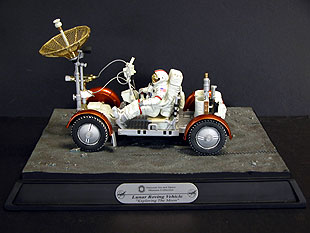
The Lunar Rover is by far the most complex of the three models. Its also my favorite.
Unlike the Apollo Astronaut or Lunar Module, which has little if any moving parts, the Lunar Rover has four mobile components in addition to its rolling wheels.
One of these, the high-gain antenna, is covered in mesh adding to the realistic appearance of this model.
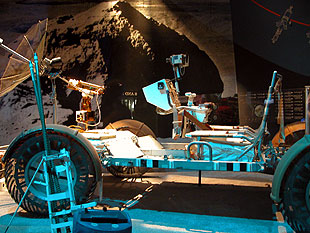
In fact, as you can see from the above photograph of the Lunar Rover test model at the National Air and Space Museum, this model comes the closest to accurately replicating the hardware it depicts.
The primary difference between the real Lunar Rover and Code 3 Collectibles' replica are the wheels. On the model, the wheels are solid, but in reality they were woven from piano wire. The change is understandable though; NASA's own ground-based trainers couldn't use the mesh tires as they wouldn't support the weight of the chassis. (If you look carefully at the National Air and Space Museum's rover, you can see a support bar underneath, midway between the axles.)
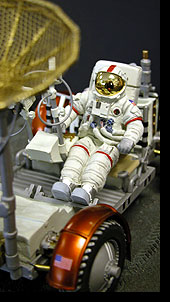 Accompanying the Lunar Rover is an astronaut in the seated position. His arm is outstretched so that he can grab hold of the navigation controls. Accompanying the Lunar Rover is an astronaut in the seated position. His arm is outstretched so that he can grab hold of the navigation controls.
Like the other two models, the included base is sculpted to represent the lunar surface. Instead of footprints, tracks create the appearance that the rover just drove into view.
Consistent with the others, details are plated in 24k gold, in this case, the astronaut's helmet visor.
|
As touched on earlier, four components attach to the chassis: the high-gain antenna, television camera, navigation console, and astronaut driver. The first three are connected by thin wiring. The effect is a dynamic model that truly appears to be in motion.
With the nation's aerospace archives open to their artists, one only needs to look at Code 3 Collectibles fire and rescue line to imagine the possibilties of their National Air and Space Museum collection.
According to Code 3 Collectibles, their next release will debut sometime in the spring. As to what will be modeled, all they will hint to is that their 2003 line will include the "air" in Air and Space.
Regardless the subject, if Code 3 Collectibles takes the same care as they have for their Apollo Astronaut, Lunar Module, and Lunar Rover, than they should be a welcome addition to any space memorabilia collection.
Visit buySPACE to order and watch collectSPACE for information on their upcoming releases.
|

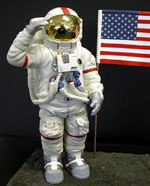


 At left is Cernan's actual suit, as it appears on display at the National Air and Space Museum. It is missing the Portable Life Support System (PLSS) backpack, as it was left on the Moon to save weight.
At left is Cernan's actual suit, as it appears on display at the National Air and Space Museum. It is missing the Portable Life Support System (PLSS) backpack, as it was left on the Moon to save weight.

 Not that I am suggeting that Code 3 Collectibles needed a miniature for inspiration. No, they had something much larger.
Not that I am suggeting that Code 3 Collectibles needed a miniature for inspiration. No, they had something much larger.


 Accompanying the Lunar Rover is an astronaut in the seated position. His arm is outstretched so that he can grab hold of the navigation controls.
Accompanying the Lunar Rover is an astronaut in the seated position. His arm is outstretched so that he can grab hold of the navigation controls.